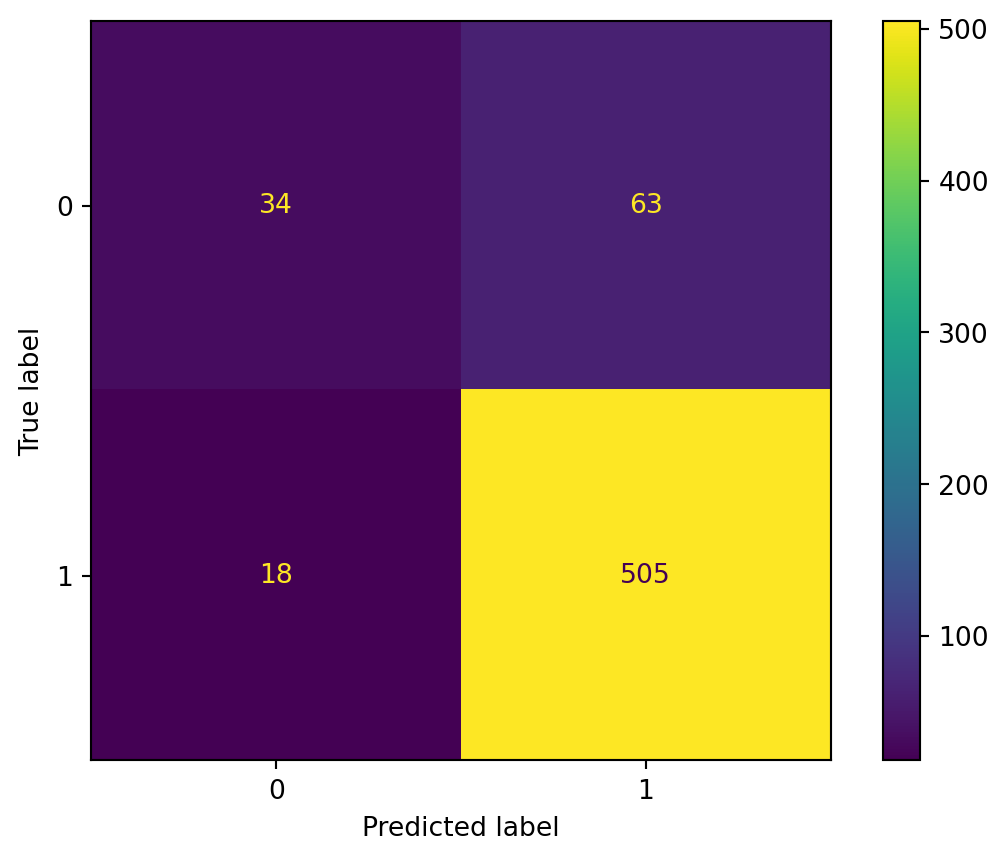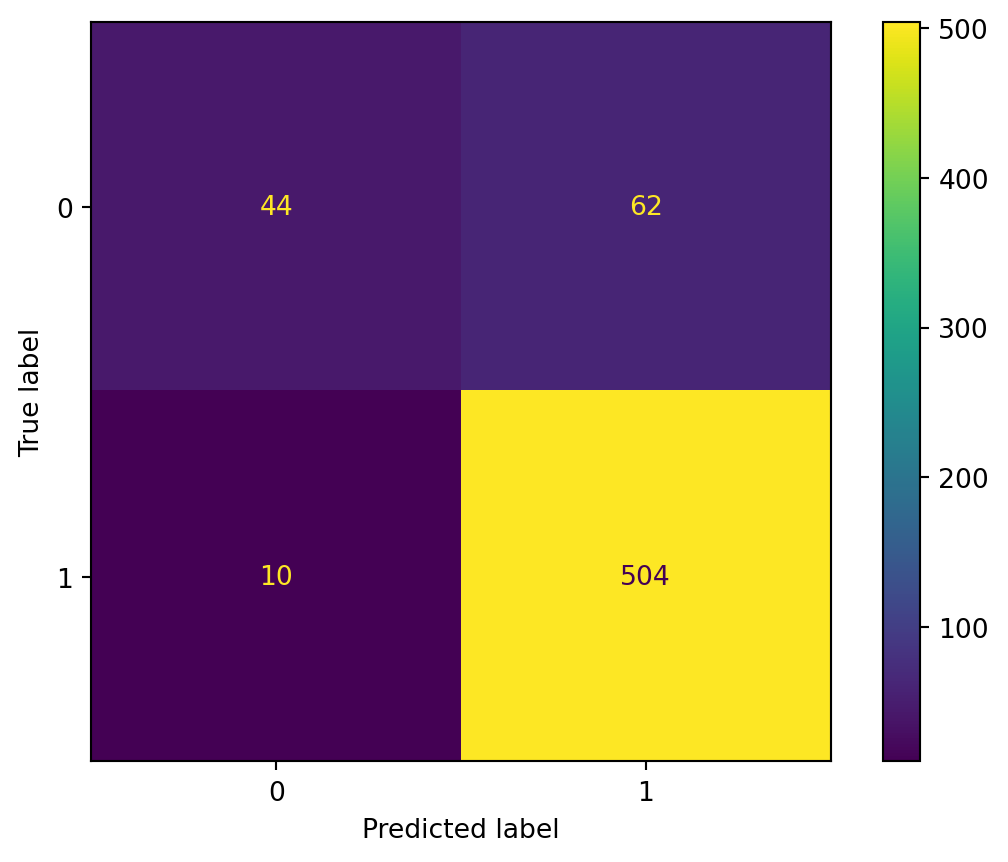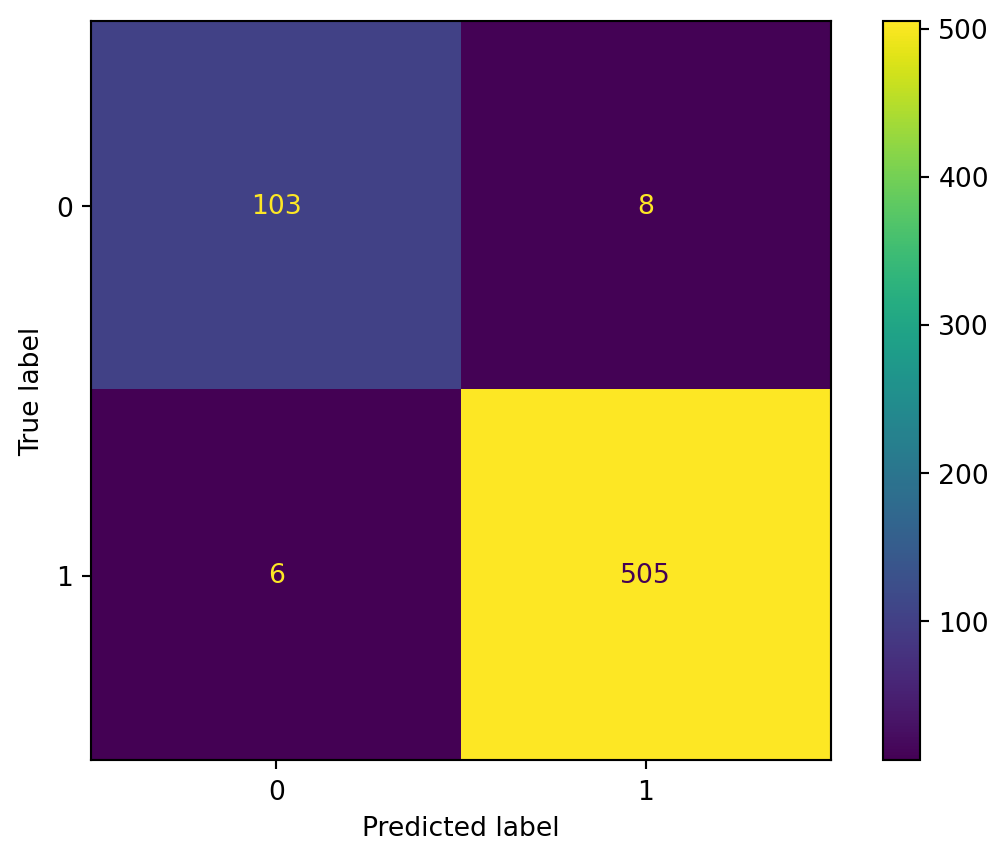!pip install geopandas openpyxl plotnine plotly1 Introduction
This chapter aims to very briefly introduce the principle of training models in a classification context. The goal is to illustrate the process using an algorithm with an intuitive principle. It seeks to demonstrate some of the concepts discussed in previous chapters, particularly those related to model training. Other courses in your curriculum will allow you to explore additional classification algorithms and the limitations of each technique.
1.1 Data
Machine learning materials in this course uses a unique dataset, presented in the introduction. All examples are based on US county level presidential election results combined with sociodemographic variables. Source code for data ingestion is available on Github.
import requests
url = 'https://raw.githubusercontent.com/linogaliana/python-datascientist/main/content/modelisation/get_data.py'
r = requests.get(url, allow_redirects=True)
open('getdata.py', 'wb').write(r.content)
import getdata
votes = getdata.create_votes_dataframes()1.2 The SVM Method (Support Vector Machines)
SVM (Support Vector Machines) is part of the traditional toolkit for data scientists. The principle of this technique is relatively intuitive thanks to its geometric interpretation. The goal is to find a line, with margins (supports), that best separates the point cloud in our data. Of course, in real life, it is rare to have well-organized point clouds that can be separated by a line. However, an appropriate projection (a kernel) can transform the data to enable separation.
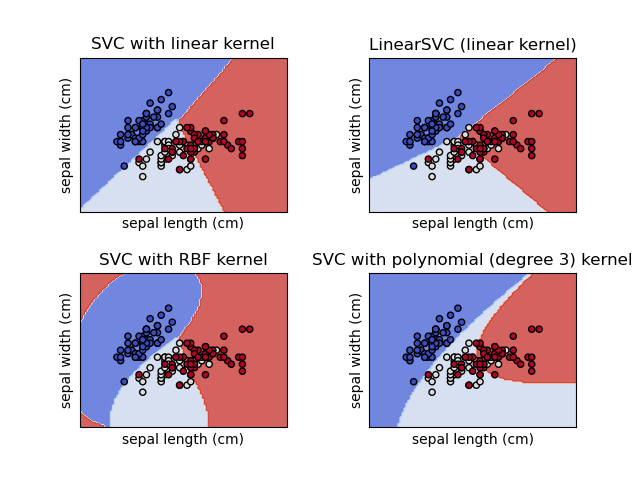
SVM is one of the most intuitive machine learning methods due to its simple geometric interpretation. It is also one of the least complex machine learning algorithms in terms of formalization for practitioners familiar with traditional statistics. This note provides an overview, though it is not essential for understanding this chapter. In machine learning, more than the mathematical details, the key is to build intuitions.
The goal of SVM, let us recall, is to find a hyperplane that best separates the different classes. For example, in a two-dimensional space, it aims to find a line with margins that best divides the space into regions with homogeneous labels.
Without loss of generality, we can assume the problem involves a probability distribution \(\mathbb{P}(x,y)\) (\(\mathbb{P} \to \{-1,1\}\)) that is unknown. The goal of classification is to build an estimator of the ideal decision function that minimizes the probability of error. In other words
\[ \theta = \arg\min_\Theta \mathbb{P}(h_\theta(X) \neq y |x) \]
The simplest SVMs are linear SVMs. In this case, it is assumed that a linear separator exists that can assign each class based on its sign:
\[ h_\theta(x) = \text{signe}(f_\theta(x)) ; \text{ avec } f_\theta(x) = \theta^T x + b \] avec \(\theta \in \mathbb{R}^p\) et \(w \in \mathbb{R}\).
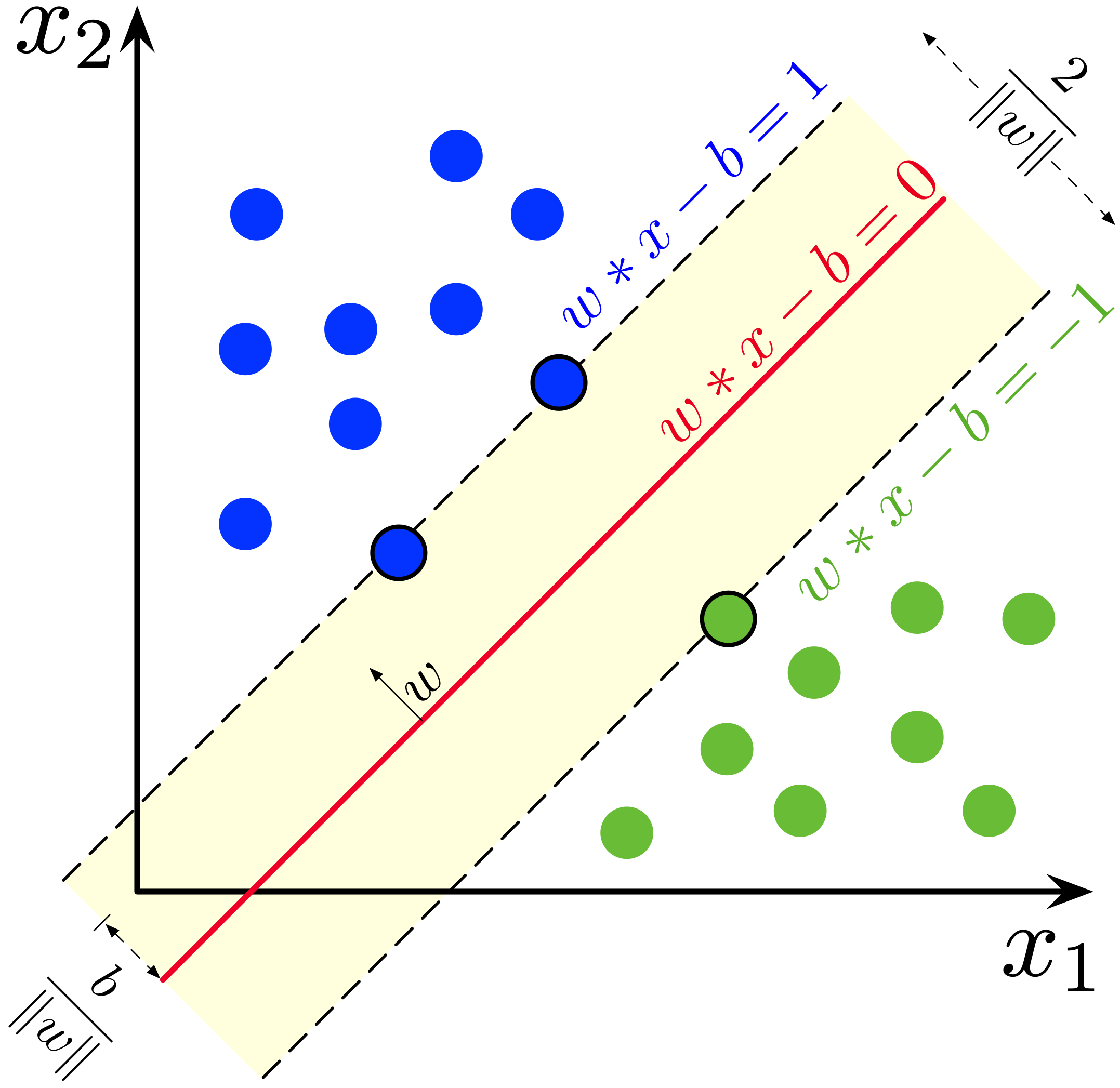
When observations are linearly separable, there is an infinite number of linear decision boundaries separating the two classes. The “best” choice is to select the maximum margin that separates the data. The distance between the two margins is \(\frac{2}{||\theta||}\). Thus, maximizing this distance between two hyperplanes is equivalent to minimizing \(||\theta||^2\) under the constraint \(y_i(\theta^Tx_i + b) \geq 1\).
In the non-linearly separable case, the hinge loss \(\max\big(0,y_i(\theta^Tx_i + b)\big)\) allows for linearizing the loss function, resulting in the following optimization problem:
\[ \frac{1}{n} \sum_{i=1}^n \max\big(0,y_i(\theta^Tx_i + b)\big) + \lambda ||\theta||^2 \]
Generalization to the non-linear case involves introducing kernels that transform the coordinate space of the observations.
2 Application
To apply a classification model, we need to find a dichotomous variable. The natural choice is to use the dichotomous variable of a party’s victory or defeat.
Even though the Republicans lost in 2020, they won in more counties (less populated ones). We will consider a Republican victory as our label 1 and a defeat as 0.
from sklearn import svm
import sklearn.metrics
from sklearn.model_selection import train_test_split
from sklearn.model_selection import cross_val_score
import matplotlib.pyplot as plt- Create a dummy variable called
ywith a value of 1 when the Republicans win. - Using the ready-to-use function
train_test_splitfrom thesklearn.model_selectionlibrary, create test samples (20% of the observations) and training samples (80%) with the following features:
xvars = [
"Unemployment_rate_2019", "Median_Household_Income_2021",
"Percent of adults with less than a high school diploma, 2018-22",
"Percent of adults with a bachelor's degree or higher, 2018-22"
]and use the variable y as the label.
Train an SVM classifier with a regularization parameter
C = 1. Examine the following performance metrics:accuracy,f1,recall, andprecision.Check the confusion matrix: despite seemingly reasonable scores, you should notice a significant issue.
Repeat the previous steps using normalized variables. Are the results different?
Change the x variables. Use only the previous Democratic vote result (2016) and income. Variables in question are
share_2016_republicanandMedian_Household_Income_2021. Examine results, in particular the confusion matrix.[OPTIONAL] Perform 5-fold cross-validation to determine the ideal C parameter.
We thus obtain a set of training features with the following structure:
| Unemployment_rate_2019 | Median_Household_Income_2021 | Percent of adults with less than a high school diploma, 2018-22 | Percent of adults with a bachelor's degree or higher, 2018-22 | |
|---|---|---|---|---|
| 2588 | 3.7 | 48166.0 | 14.928228 | 19.153438 |
| 1216 | 3.7 | 42225.0 | 24.007613 | 11.025014 |
| 1535 | 3.5 | 63984.0 | 9.895525 | 21.062488 |
| 1473 | 3.7 | 57465.0 | 14.014559 | 18.742772 |
| 1224 | 4.5 | 58741.0 | 7.777468 | 24.420876 |
And the associated labels are as follows:
2747 0
1459 1
2801 1
2777 1
2953 1
..
720 1
2296 1
1788 1
2178 1
730 1
Name: y, Length: 620, dtype: int64At the end of question 3, our classifier completely misses the 0 labels, which are in the minority. One possible reason is the scale of the variables. Income, in particular, has a distribution that can dominate the others in a linear model. Therefore, at a minimum, it is necessary to standardize the variables, which is the focus of question 4.
Standardizing the variables ultimately does not bring any improvement:
It is therefore necessary to go further: the problem does not lie in the scale but in the choice of variables. This is why the step of variable selection is crucial and why a chapter is dedicated to it.
At the end of question 6, the new classifier should have the following performance:
Informations additionnelles
This site was built automatically through a Github action using the Quarto
The environment used to obtain the results is reproducible via uv. The pyproject.toml file used to build this environment is available on the linogaliana/python-datascientist repository
pyproject.toml
[project]
name = "python-datascientist"
version = "0.1.0"
description = "Source code for Lino Galiana's Python for data science course"
readme = "README.md"
requires-python = ">=3.12,<3.13"
dependencies = [
"altair==5.4.1",
"black==24.8.0",
"cartiflette",
"contextily==1.6.2",
"duckdb>=0.10.1",
"folium>=0.19.6",
"geoplot==0.5.1",
"graphviz==0.20.3",
"great-tables==0.12.0",
"ipykernel>=6.29.5",
"jupyter>=1.1.1",
"jupyter-cache==1.0.0",
"kaleido==0.2.1",
"langchain-community==0.3.9",
"loguru==0.7.3",
"markdown>=3.8",
"nbclient==0.10.0",
"nbformat==5.10.4",
"nltk>=3.9.1",
"pip>=25.1.1",
"plotly>=6.1.2",
"plotnine>=0.15",
"polars==1.8.2",
"pyarrow==17.0.0",
"pynsee==0.1.8",
"python-dotenv==1.0.1",
"pywaffle==1.1.1",
"requests>=2.32.3",
"scikit-image==0.24.0",
"scipy==1.13.0",
"selenium<4.39.0",
"spacy==3.8.4",
"webdriver-manager==4.0.2",
"wordcloud==1.9.3",
"xlrd==2.0.1",
"yellowbrick==1.5",
]
[tool.uv.sources]
cartiflette = { git = "https://github.com/inseefrlab/cartiflette" }
[dependency-groups]
dev = [
"nb-clean>=4.0.1",
]To use exactly the same environment (version of Python and packages), please refer to the documentation for uv.
| SHA | Date | Author | Description |
|---|---|---|---|
| 3e04ed3c | 2025-11-24 20:08:05 | lgaliana | Avoid deprecated ravel method and fix notebooks launch url |
| 94648290 | 2025-07-22 18:57:48 | Lino Galiana | Fix boxes now that it is better supported by jupyter (#628) |
| 91431fa2 | 2025-06-09 17:08:00 | Lino Galiana | Improve homepage hero banner (#612) |
| 48dccf14 | 2025-01-14 21:45:34 | lgaliana | Fix bug in modeling section |
| 8c8ca4c0 | 2024-12-20 10:45:00 | lgaliana | Traduction du chapitre clustering |
| a5ecaedc | 2024-12-20 09:36:42 | Lino Galiana | Traduction du chapitre modélisation (#582) |
| ff0820bc | 2024-11-27 15:10:39 | lgaliana | Mise en forme chapitre régression |
| bb943aab | 2024-11-26 15:18:41 | Lino Galiana | hope works (#579) |
| e7fd1ff3 | 2024-11-25 18:20:32 | lgaliana | rename classification chapter |
Citation
@book{galiana2025,
author = {Galiana, Lino},
title = {Python Pour La Data Science},
date = {2025},
url = {https://pythonds.linogaliana.fr/},
doi = {10.5281/zenodo.8229676},
langid = {en}
}


